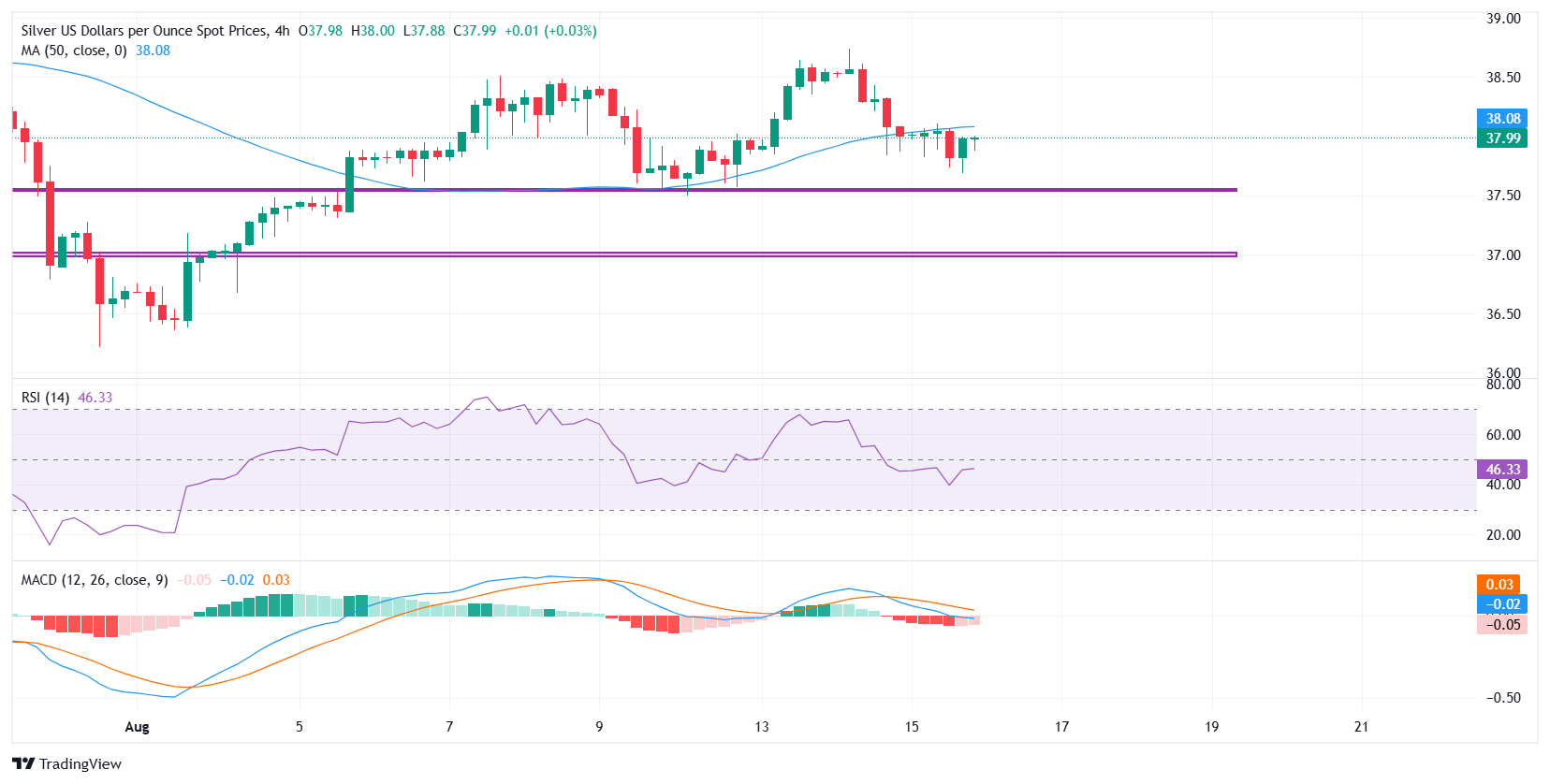- XAG/USD attempts recovery after hitting a four-day low of $37.69 but remains down nearly 1% for the week.
- The US Dollar softens amid mixed economic data, while rising US Treasury yields continue to limit Silver’s upside.
- Geopolitical focus shifts to the Trump–Putin summit in Alaska scheduled to begin later on Friday.
Silver (XAG/USD) is attempting a mild recovery on Friday after sliding to a four-day low of $37.69. The rebound comes amid some softness in the US Dollar, which is losing traction following mixed US economic data this week. However, despite the intraday bounce, the white metal remains on track for a weekly decline of nearly 1%, as rising US Treasury yields cap the upside.
At the time of writing, the metal is trading around the $38.00 psychological mark, struggling to post a meaningful recovery on the day. Geopolitical tensions remain in focus, with traders closely watching the Trump–Putin summit in Alaska, scheduled to begin later on Friday. While the talks are unlikely to produce a breakthrough, the high-profile meeting adds a layer of uncertainty to global markets and could trigger safe-haven flows. That said, Silver’s reaction has been limited so far, and with prices still capped below key resistance levels, the broader bias remains cautious heading into the weekend.

Silver (XAG/USD) remains trapped below the 50-period Simple Moving Average (SMA) on the 4-hour chart, currently positioned at $38.08, which continues to act as immediate resistance. The metal is consolidating just beneath this dynamic barrier after rebounding from a key support area near the $ 37.50 level that has repeatedly cushioned declines this week.
Despite the modest rebound, price action lacks conviction, with bulls struggling to regain control above the short-term moving average. The broader structure appears range-bound, with sellers defending the $38.10–$38.20 zone and buyers stepping in near $37.50
Momentum indicators offer little clarity, with the Relative Strength Index (RSI) pointing north near 47, showing limited bullish momentum, while the Moving Average Convergence Divergence (MACD) is flatlining just below the zero line, hinting at indecision.
A sustained move above the $38-38.10 resistance is needed to confirm bullish continuation toward $38.50, followed by $39.00. On the flip side, a breakdown below $37.50 could expose the psychological $37.00 handle and shift the short-term bias in favor of the bears.
Silver FAQs
Silver is a precious metal highly traded among investors. It has been historically used as a store of value and a medium of exchange. Although less popular than Gold, traders may turn to Silver to diversify their investment portfolio, for its intrinsic value or as a potential hedge during high-inflation periods. Investors can buy physical Silver, in coins or in bars, or trade it through vehicles such as Exchange Traded Funds, which track its price on international markets.
Silver prices can move due to a wide range of factors. Geopolitical instability or fears of a deep recession can make Silver price escalate due to its safe-haven status, although to a lesser extent than Gold’s. As a yieldless asset, Silver tends to rise with lower interest rates. Its moves also depend on how the US Dollar (USD) behaves as the asset is priced in dollars (XAG/USD). A strong Dollar tends to keep the price of Silver at bay, whereas a weaker Dollar is likely to propel prices up. Other factors such as investment demand, mining supply – Silver is much more abundant than Gold – and recycling rates can also affect prices.
Silver is widely used in industry, particularly in sectors such as electronics or solar energy, as it has one of the highest electric conductivity of all metals – more than Copper and Gold. A surge in demand can increase prices, while a decline tends to lower them. Dynamics in the US, Chinese and Indian economies can also contribute to price swings: for the US and particularly China, their big industrial sectors use Silver in various processes; in India, consumers’ demand for the precious metal for jewellery also plays a key role in setting prices.
Silver prices tend to follow Gold’s moves. When Gold prices rise, Silver typically follows suit, as their status as safe-haven assets is similar. The Gold/Silver ratio, which shows the number of ounces of Silver needed to equal the value of one ounce of Gold, may help to determine the relative valuation between both metals. Some investors may consider a high ratio as an indicator that Silver is undervalued, or Gold is overvalued. On the contrary, a low ratio might suggest that Gold is undervalued relative to Silver.

